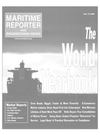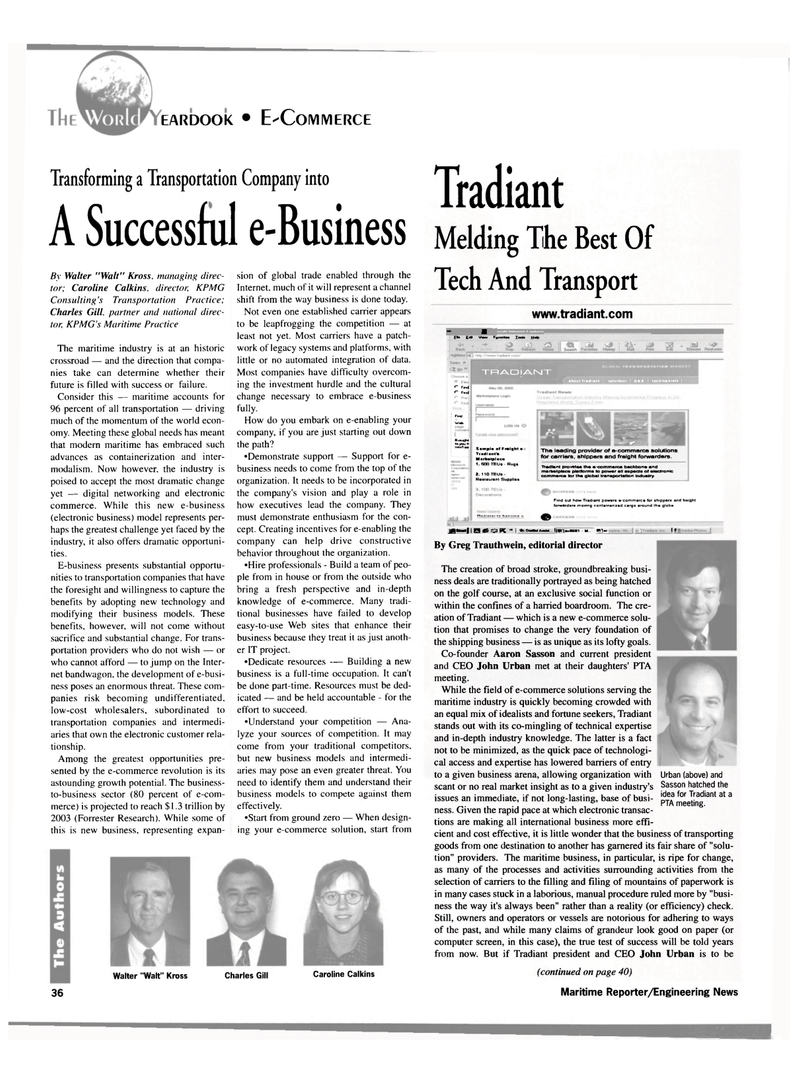
Page 40: of Maritime Reporter Magazine (June 15, 2000)
Read this page in Pdf, Flash or Html5 edition of June 15, 2000 Maritime Reporter Magazine
EARDOOK • E'COMMERCE
Transforming a Transportation Company into
A Successful e-Business
By Walter "Walt" Kross, managing direc- tor; Caroline Calkins, director, KPMG
Consulting's Transportation Practice;
Charles Gill, partner and national direc- tor, KPMG's Maritime Practice
The maritime industry is at an historic crossroad — and the direction that compa- nies take can determine whether their future is filled with success or failure.
Consider this — maritime accounts for 96 percent of all transportation — driving much of the momentum of the world econ- omy. Meeting these global needs has meant that modern maritime has embraced such advances as containerization and inter- modalism. Now however, the industry is poised to accept the most dramatic change yet — digital networking and electronic commerce. While this new e-business (electronic business) model represents per- haps the greatest challenge yet faced by the industry, it also offers dramatic opportuni- ties.
E-business presents substantial opportu- nities to transportation companies that have the foresight and willingness to capture the benefits by adopting new technology and modifying their business models. These benefits, however, will not come without sacrifice and substantial change. For trans- portation providers who do not wish — or who cannot afford — to jump on the Inter- net bandwagon, the development of e-busi- ness poses an enormous threat. These com- panies risk becoming undifferentiated, low-cost wholesalers, subordinated to transportation companies and intermedi- aries that own the electronic customer rela- tionship.
Among the greatest opportunities pre- sented by the e-commerce revolution is its astounding growth potential. The business- to-business sector (80 percent of e-com- merce) is projected to reach $1.3 trillion by 2003 (Forrester Research). While some of this is new business, representing expan- sion of global trade enabled through the
Internet, much of it will represent a channel shift from the way business is done today.
Not even one established carrier appears to be leapfrogging the competition — at least not yet. Most carriers have a patch- work of legacy systems and platforms, with little or no automated integration of data.
Most companies have difficulty overcom- ing the investment hurdle and the cultural change necessary to embrace e-business fully.
How do you embark on e-enabling your company, if you are just starting out down the path? •Demonstrate support — Support for e- business needs to come from the top of the organization. It needs to be incorporated in the company's vision and play a role in how executives lead the company. They must demonstrate enthusiasm for the con- cept. Creating incentives for e-enabling the company can help drive constructive behavior throughout the organization. •Hire professionals - Build a team of peo- ple from in house or from the outside who bring a fresh perspective and in-depth knowledge of e-commerce. Many tradi- tional businesses have failed to develop easy-to-use Web sites that enhance their business because they treat it as just anoth- er IT project. •Dedicate resources — Building a new business is a full-time occupation. It can't be done part-time. Resources must be ded- icated — and be held accountable - for the effort to succeed. •Understand your competition — Ana- lyze your sources of competition. It may come from your traditional competitors, but new business models and intermedi- aries may pose an even greater threat. You need to identify them and understand their business models to compete against them effectively. •Start from ground zero — When design- ing your e-commerce solution, start from
Walter "Walt" Kross Charles Gill Caroline Calkins
Tradiant
Melding The Best Of
Tech And Transport www.tradiant.com ¥ iiiMYwa
Ete £<* Favorites loots tfefc sa- <~ FMD <~ Fin.*
I Find \
Web
BROUGHT (oyoub
InloSn
TRADIANT about Tradiant I solution; I Oft A I testimonials I
Sample of Freight o
Tradiant's
Marketplace 1. 500 TEUs - Rugs 2. 110 TEUs -
Restaurant Supplies
REGISTER IG BECOME Q -
The leading provider of e-commerce solutions for carriers, shippers and freight forwarders.
Tradiant provides the e-commerce backbone and marketplace platforms to power all aspects of electronic commerce for the global transportation industry.
Find out how Tradiant powers e-commerce for shippers and freight forwarders moving containerized cargo around the globe. © jgStartf i a 05 £3 PC **il Jfcsoi—«A>««t. ilPv miOSOt - M.. -EiS It 36
By Greg Trauthwein, editorial director
The creation of broad stroke, groundbreaking busi- ness deals are traditionally portrayed as being hatched on the golf course, at an exclusive social function or within the confines of a harried boardroom. The cre- ation of Tradiant — which is a new e-commerce solu- tion that promises to change the very foundation of the shipping business — is as unique as its lofty goals.
Co-founder Aaron Sasson and current president and CEO John Urban met at their daughters' PTA meeting.
While the field of e-commerce solutions serving the maritime industry is quickly becoming crowded with an equal mix of idealists and fortune seekers, Tradiant stands out with its co-mingling of technical expertise and in-depth industry knowledge. The latter is a fact not to be minimized, as the quick pace of technologi- cal access and expertise has lowered barriers of entry to a given business arena, allowing organization with scant or no real market insight as to a given industry's issues an immediate, if not long-lasting, base of busi- ness. Given the rapid pace at which electronic transac- tions are making all international business more effi- cient and cost effective, it is little wonder that the business of transporting goods from one destination to another has garnered its fair share of "solu- tion" providers. The maritime business, in particular, is ripe for change, as many of the processes and activities surrounding activities from the selection of carriers to the filling and filing of mountains of paperwork is in many cases stuck in a laborious, manual procedure ruled more by "busi- ness the way it's always been" rather than a reality (or efficiency) check.
Still, owners and operators or vessels are notorious for adhering to ways of the past, and while many claims of grandeur look good on paper (or computer screen, in this case), the true test of success will be told years from now. But if Tradiant president and CEO John Urban is to be (continued on page 40)
Maritime Reporter/Engineering News
Urban (above) and
Sasson hatched the idea for Tradiant at a
PTA meeting.

 39
39

 41
41
